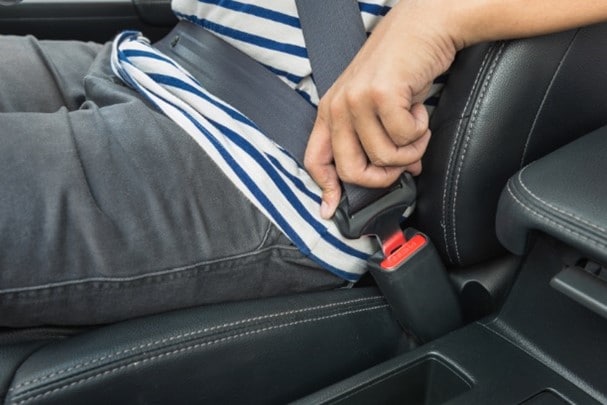Seat Belts: Get the Facts

Motor vehicle crashes are a leading cause of death among people aged 1-54 in the United States.1 Most crash-related deaths in the United States occur to drivers and passengers.5
Seat belt use is the most effective way to save lives and reduce injuries in crashes for adults and older children who are big enough for seat belts to fit properly.5 Yet millions do not buckle up on every trip.6
Deaths
- About 60% of the people who died in motor vehicle crashes in 2021 were drivers and passengers in passenger vehicles.5 That’s more than 26,000 people.
- More than half (range: 51%-61%) of teens 13-19 years and adults aged 20-54 years who died in crashes in 2021 were not buckled up at the time of the crash.*5
Injuries
- More than 1.8 million drivers and passengers were treated in an emergency department as the result of being injured in motor vehicle crashes in 2021.1
- Young adult drivers and passengers aged 18-28 years had the highest crash-related non-fatal injury rates among people of all ages.1
Costs
- Non-fatal crash injuries to drivers and passengers resulted in over $220 billion in lifetime medical, work, and quality of life loss costs in 2021.7
Age
- Young adults (age 18-24) are less likely to wear seat belts than those in older age groups.8
Gender
- Men are less likely to wear seat belts than women.8
Metropolitan Status
- Adults who live in non-metropolitan areas are less likely to wear seat belts than adults who live in metropolitan areas.8
State Laws
- Seat belt use is lower in states with secondary enforcement seat belt laws or no seat belt laws (90% in 2022) compared to states with primary enforcement laws (92% in 2022).9
Seating Position in Vehicle
Rear-seat motor vehicle passengers [PDF – 4 pages] are less likely than front-seat passengers to wear a seat belt,10 making them more likely to injure themselves and drivers or other passengers in a crash.11

Seat belts reduce serious crash-related injuries and deaths by about half.12
- Seat belts saved almost 15,000 lives in 2017.5
- Air bags provide added protection but are not a substitute for seat belts. Air bags plus seat belts provide the greatest protection for adults.13
Primary enforcement laws make a difference
Research shows, primary enforcement seat belt laws make a big difference in getting more people to buckle up and reducing the risk of dying in a crash.8,14 Observed seat belt use in 2022 was 92% in states with primary enforcement laws and 90% in states with secondary enforcement laws or no seat belt laws.9
A primary enforcement seat belt law means a police officer can pull a vehicle over and issue a ticket just because a driver or passenger covered by the law is not wearing a seat belt. A secondary enforcement law only allows a police officer to issue a ticket for someone not wearing a seat belt if the driver has been pulled over for some other offense. State primary and secondary seat belt laws vary by whether drivers and all passengers (i.e., front and rear seats) or drivers and only front seat passengers are required to be buckled. These requirements may also vary depending on the age of the passenger. For information on laws in each state, check with the Insurance Institute for Highway Safety at http://www.iihs.org. As of September 2023, 29 states did not have a primary enforcement law covering all seating positions for adults (ages 18+ years).15
When it comes to increasing seat belt use, individuals, government, and health professionals can help promote safety.
States can:
- Consider proven strategies for increasing seat belt use and reducing child motor vehicle injuries and deaths, which include:14,16
- Primary enforcement seat belt laws, which have been shown to increase use and reduce deaths compared with secondary enforcement laws.
- Seat belt laws that apply to everyone in the vehicle, not just those in the front seat.
- Fines for not wearing a seat belt that are high enough to be effective.
- Make sure that police and state troopers enforce all seat belt laws.
- Support seat belt laws with visible police presence and awareness campaigns for the public.
- Educate the public to make seat belt use a social norm.
Health professionals can:
- Remind patients about the importance of seat belt use on all trips and in all seats.
- Encourage patients to make wearing a seat belt a habit.
- Wear seat belts themselves and encourage their colleagues to do the same.
Parents and caregivers can:
- Use a seat belt on every trip, no matter how short. This sets a good example.
- Make sure children are properly buckled up in a car seat, booster seat, or seat belt, whichever is appropriate for their age, height, and weight.
- Properly buckle all children ages 12 and under in the back seat.
- Never place a rear-facing child safety seat in front of an air bag.
- Properly buckle children in the middle back seat when possible because it is the safest spot in the vehicle.
Everyone can:
- Use a seat belt in the front and back seats on every trip, no matter how short.
- Require everyone in the car to buckle up, including those in the back seat.
- Centers for Disease Control and Prevention. WISQARS (Web-based Injury Statistics Query and Reporting System) [online]. Atlanta, GA: US Department of Health and Human Services, CDC; 2023. Available at https://www.cdc.gov/injury/wisqars/index.html. Accessed 8 Nov 2023.
- Stewart, T. Overview of Motor Vehicle Crashes in 2021. National Highway Traffic Safety Administration, Washington, DC; 2023. Publication no. DOT-HS-813-435. Available at https://crashstats.nhtsa.dot.gov/Api/Public/ViewPublication/813435. Accessed 7 Sept 2023.
- National Highway Traffic Safety Administration. Seat Belt Use in 2022 – Use Rates in the States and Territories. U.S. Department of Transportation, Washington, DC; 2023. Publication no. DOT-HS-813-487. Available at https://crashstats.nhtsa.dot.gov/Api/Public/Publication/813487. Accessed 8 Nov 2023.
- National Highway Traffic Safety Administration. Occupant Restraint Use in 2022: Results From the NOPUS Controlled Intersection Study. U.S. Department of Transportation, Washington, DC; 2023. Publication no. DOT-HS-813-523. Available at https://crashstats.nhtsa.dot.gov/Api/Public/ViewPublication/813523. Accessed 8 Nov 2023.
- National Highway Traffic Safety Administration. Traffic Safety Facts: 2021 Data: Occupant Protection in Passenger Vehicles. U.S. Department of Transportation, Washington, DC; 2023. Publication no. DOT-HS-813-449. Available at https://crashstats.nhtsa.dot.gov/Api/Public/ViewPublication/813449. Accessed 1 Aug 2023.
- Shakya I, Shults RA, Stevens MR, et al. State-level seat belt use in the United States: Comparison of self-reported with observed use and use by fatally injured occupants. Journal of Safety Research 2020;73:103-109. DOI: https://doi.org/10.1016/j.jsr.2020.02.015
- Centers for Disease Control and Prevention. WISQARS (Web-based Injury Statistics Query and Reporting System). Cost of Injury Reports. Atlanta, GA: US Department of Health and Human Services, CDC; 2014. Available at https://www.cdc.gov/injury/wisqars/cost/index.html. Accessed 8 Nov 2023.
- Beck LF, Downs J, Stevens MR, Sauber-Schatz EK. Rural and urban differences in passenger-vehicle–occupant deaths and seat belt use among adults — United States, 2014. MMWR Surveill Summ 2017;66(No. SS-17):1–13. DOI: https://dx.doi.org/10.15585/mmwr.ss6617a1.
- National Highway Traffic Safety Administration. Traffic Safety Facts: Seat Belt Use in 2022—Overall Results. US Department of Transportation, Washington, DC; 2023. Publication no. DOT-HS-813-407. Available at https://crashstats.nhtsa.dot.gov/Api/Public/ViewPublication/813407. Accessed 26 Jun 2023.
- Bhat G, Beck L, Bergen G, Kresnow M. Predictors of rear seat belt use among US adults, 2012. Journal of Safety Research 2015;53:103-106. DOI: https://doi.org/10.1016/j.jsr.2015.03.011
- Bose D, Arregui-Dalmases C, Sanchez-Molina D, et al. Increased risk of driver fatality due to unrestrained rear-seat passengers in severe frontal crashes. Accident Analysis and Prevention 2013;53:100-4. DOI: https://doi.org/10.1016/j.aap.2012.11.031
- Kahane CJ. National Highway Traffic Safety Administration. Fatality reduction by safety belts for front-seat occupants of cars and light trucks: updated and expanded estimates based on 1986-99 FARS data. U.S. Department of Transportation; Washington, DC, 2000. Publication no. DOT-HS-809-199. Available at https://crashstats.nhtsa.dot.gov/Api/Public/ViewPublication/809199. Accessed 1 Aug 2023.
- National Highway Traffic Safety Administration. Fifth / sixth report to Congress: effectiveness of occupant protection systems and their use. US Department of Transportation, Washington, DC; 2001. Publication no. DOT-HS-809-442. Available at https://crashstats.nhtsa.dot.gov/Api/Public/Publication/809442. Accessed 19 Oct 2023.
- Dinh-Zarr TB, Sleet DA, Shults RA, et al. Reviews of evidence regarding interventions to increase the use of safety belts. American Journal Preventive Medicine 2001;21(4S): 48-65. DOI: https://doi.org/10.1016/S0749-3797(01)00378-6
- Insurance Institute for Highway Safety. Highway Loss Data Institute. State Laws: Safety Belts―Safety Belts and Child Safety Seats. Arlington, VA: Insurance Institute for Highway Safety/Highway Loss Data Institute; 2023. Available at https://www.iihs.org/topics/seat-belts#laws?topicName=safety-belts. Accessed 1 Aug 2023.
- Venkatraman V, Richard CM, Magee K, Johnson K. National Highway Traffic Safety Administration. Countermeasures that work: A highway safety countermeasure guide for State highway safety offices, Tenth edition. U.S. Department of Transportation, Washington, DC; 2021. Publication no. DOT HS 813 097. Available at: https://www.nhtsa.gov/sites/nhtsa.gov/files/2021-09/Countermeasures-10th_080621_v5_tag.pdf [PDF – 641 pages]. Accessed 8 Sept 2023.
- National Highway Traffic Safety Administration What is a Safe Systems Approach? [online]. Washington, DC: U.S. Department of Transportation, National Highway Traffic Safety Administration; 2023. Available at https://www.transportation.gov/NRSS/SafeSystem. Accessed 23 Oct 2023.